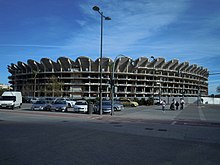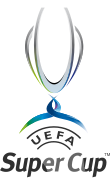Estadio Mestalla
| Estadio Mestalla | |
|---|---|
| Camp del València | |

|
|
| Before the game for the Trofeu Taronja on August 12, 2011 between Valencia CF and AS Roma . | |
| Data | |
| place | Avenida Suecia s / n 46010 Valencia , Spain |
| Coordinates | 39 ° 28 ′ 29 ″ N , 0 ° 21 ′ 30 ″ W |
| owner | Valencia CF |
| opening | May 20, 1923 |
| First game | May 20, 1923 Valencia CF - Levante UD 1-0 |
| Renovations | 1927, 1940, 1945–1946, 1959, 1972, 1973, 1982, 1989, 2013–2014 |
| surface | Natural grass |
| architect | Francisco Almenar Quinzá |
| capacity | 55,000 seats |
| playing area | 105 m × 70 m |
| Societies) | |
| Events | |
The Estadio Mestalla ( Valencian : Estadi de Mestalla , German Mestalla Stadium ), officially Mestalla, Camp del València , is a football stadium in Valencia , Spain . It is the home of the Spanish first division club Valencia CF and with a capacity for 55,000 spectators the largest stadium in the city of Valencia.
history
The Estadio Mestalla was named after one of the canals that irrigate the fertile orchards in the vicinity of Valencia. The Turia River used to flow through the city and the stadium is across the dried-up river bed that now houses the Turia Gardens, in what is now the neighborhood of the same name. The first game and thus the opening of the stadium took place on May 20, 1923 against local rivals UD Levante . Just four years later, expansion work began to increase the original capacity of 17,000, and in 1931 Valencia CF rose to the Primera División .
Since Valencia was the last city to offer resistance to the Francoists during the civil war, the stadium was also seriously damaged and it survived the clashes poorly. Later it was even used as a concentration camp and junkyard. What ultimately remained of the stadium were the foundation walls and a damaged grandstand.
Game operations in Mestalla were soon resumed, however, and in 1941 Valencia CF won their first trophy, the Spanish Cup. Three championships and another trophy followed, which benefited the complete renovation of the stadium during the 1950s. At that time, the east and west stands, the latter with an upper tier, were built to accommodate 45,000 fans.
In 1959 the stadium got its first floodlight system and from then on it could also be the venue for international meetings. The first foreign team to appear here was Nottingham Forest .
In 1982 the stadium was named " Luis Casanova ", which goes back to the then president, and was the venue for the World Cup . For this reason, the playing area was lowered so that another upper tier could be added. The third, acute-angled tier, which gives the standing grandstand its horseshoe shape, followed in the late 1990s. In 1994 the stadium got its original name "Mestalla" back at the request of President Casanova.
Current
On December 28, 2004, Valencia CF received approval from the port city's authorities to demolish the arena and build on the site. The days of the Mestalla Stadium are numbered. A residential complex is being built in place of the stadium, the plans for this have been published on the club's official website.
New arena in Valencia
The club originally wanted to raise up to 320 million euros by selling the Mestalla stadium to the city of Valencia. Of this, around 120 million euros should be used for debt repayment. A stadium with around 70,000 seats will be built of the rest (up to 200 million euros), which should be completed by around August 2010. In June 2006, President Juan Soler announced that the design for the new stadium was now final. The new stadium will be called Nou Mestalla .
Due to the real estate crisis, no buyer could be found for the old stadium and its grounds. The club planned with revenues of around 400 million euros. Due to the lack of these revenues, the club ran into financial problems, which is why work on the new stadium had to be stopped in February 2009. It is therefore still played in the Mestalla. In December 2011 it was announced that the Spanish savings bank Bankia, which is also the main creditor of the club, will take over the property and in return will cancel the club's debts of 250 million euros and provide it with a further loan of 110 million euros. Accordingly, work on the new stadium should continue and be ready by the end of 2013. In the meantime, the opening date of the new stadium has been postponed to the club's 100th birthday in 2019.
On October 3, 2017, Valencia CF announced that the stadium construction should be completed by May 2021. At the end of May 2019, Valencia CF found a buyer for the old Mestalla with the building cooperative ADU Mediterráneo. For this purpose, 70 percent of the planned apartments had to be reserved, it was even 80 percent. The sale with the sum of 113 million euros was thus concluded. An agreement should be reached in October of that year. The opening date seemed to be possible in mid-2022. At the end of March 2020 it was announced that the sale did not take place. As a result, the association still lacks the financial means for further construction work on Nou Mestalla. A buyer has to be found again. In the meantime, the new building has shrunk to the size of the old stadium with 55,000 seats for cost reasons. The complex facade has also been redesigned.
Fans
The fans of FC Valencia known as Ché (which means something like "colleague" in Valencian) are among the most fanatical fans in Spain. Since the standing bars come close to the pitch, the guest teams often feel as if they are under siege. The loudest of the fans can be found on the upper tier El Gol Gran ; their battle cry is “Que bote Mestalla!” ( “Let the Mestalla tremble!” ). Another group, the so-called Los Yumos , was the first in the country to practice choreography.
Spain's most famous fan, Manolo , the drummer, can no longer be found in the stadium at every home game of the Valencians. Since the club did not send him a ticket for the Champions League final in 2001, he only goes to the national team's games in the stadium. Nevertheless, he is so internationally known that even the drummer from Gladbach was named after him. Manolo is referred to as a chaquetero ( turning neck ) because he allegedly was once a fan of Real Zaragoza, which he denies himself. In front of the stadium, he owns the famous El Bombo ('the drum') bar .
Others
In addition to the home games of FC Valencia, the Mestalla Stadium also often hosts games of the Spanish national team . At the 1982 World Cup, Spain played their group matches here, but had to move to Madrid in the second round because the stadiums were larger there.
In the past, concerts often took place in the stadium, but they have been dispensed with since the 1990s.
Details
-
Transport connections :
- Airport: Valencia Airport
- Metro station: Facultats (line 3) and Aragón (line 5)
- Railway station: Estació del Nord
gallery
See also
Web links
- valenciacf.com: History of the Estadio Mestalla (Spanish)
- stadionwelt.de: Stadium guide with picture gallery
- stadiumdb.com: Images from the future Nou Mestalla (English)
- stadiumdb.com: Construction site pictures of the Nou Mestalla (English)
References and footnotes
- ↑ valenciacf.com: Estadio Mestalla (Spanish)
- ↑ Archive link ( Memento of the original from March 10, 2007 in the Internet Archive ) Info: The archive link was inserted automatically and has not yet been checked. Please check the original and archive link according to the instructions and then remove this notice.
- ↑ Schmidt, Kathrin: Stadium construction in Valencia continues ( memento of the original from September 24, 2015 in the Internet Archive ) Info: The archive link was automatically inserted and not yet checked. Please check the original and archive link according to the instructions and then remove this notice. , December 13, 2011, accessed December 13, 2011
- ↑ Completion could be delayed further. Stadionwelt, August 26, 2014, accessed October 25, 2014 .
- ↑ Valencia: Mestalla's fate sealed. In: stadiumdb.com. May 14, 2019, accessed on July 6, 2020 .
- ↑ Valencia: No sale, no money for Nou Mestalla. In: stadiumdb.com. March 31, 2020, accessed on July 6, 2020 .






